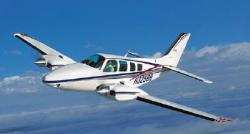Aero-Tips!
A good pilot is always learning -- how many times have you
heard this old standard throughout your flying career? There is no
truer statement in all of flying (well, with the possible exception
of "there are no old, bold pilots.")

Aero-News has called upon the expertise of Thomas P. Turner,
master CFI and all-around-good-guy, to bring our readers -- and us
-- daily tips to improve our skills as aviators. Some of them, you
may have heard before... but for each of us, there will also be
something we might never have considered before, or something that
didn't "stick" the way it should have the first time we memorized
it for the practical test.
Look for our daily Aero-Tips segments, coming each day to
you through the Aero-News Network.
Aero-Tips 06.21.06
Planning on flying a high-altitude pressurized aircraft? Then
you'll need special training.

FAR 61.31g tells us to act as
pilot-in-command (PIC) of a pressurized airplane that has a service
ceiling or maximum operating altitude above 25,000 feet you must
--
- receive and log ground and flight training from an authorized
instructor and
- obtain a logbook endorsement or training record from an
authorized instructor who certifies the person has satisfactorily
accomplished the ground training.
Note: There are no specific FAA requirements
for the "authorized instructor" to provide this training, other
than being "authorized" by virtue of holding an FAA instructor
certificate or otherwise being recognized by the FAA to conduct
training (example: a non-CFI pilot instructor working in an FAR 142
simulator training facility).
What training must cover
Ground training must cover at least the following:
- High-altitude aerodynamics and meteorology;
- Respiration;
- Effects, symptoms, and causes of hypoxia and any other
high-altitude sickness;
- Duration of consciousness without supplemental oxygen;
- Effects of prolonged usage of supplemental oxygen;
- Causes and effects of gas expansion and gas bubble
formation;
- Preventive measures for eliminating gas expansion, gas bubble
formation, and high-altitude sickness;
- Physical phenomena and incidents of decompression; and
- Any other physiological aspects of high-altitude flight.
Flight training must take place in a pressurized aircraft or a
flight simulator or flight traiing device representative of a
pressurized aircraft, and include at least:
- Normal cruise flight operations while operating above 25,000
feet MSL;
- Proper emergency procedures for simulated rapid decompression
without actually depressurizing the aircraft; and
- Emergency descent procedures.
Note that the majority of training addresses keeping
yourself alive in a high altitude environment, and getting down
fast if something goes wrong with the pressurization.
Exceptions: if you logged PIC in a pressurized
airplane (or a flight simulator/flight training device
representative of a pressurized aircraft) before April 15, 1991,
complete a U.S. military PIC check or pass a Part 121, 125 or 135
check pilot as PIC the so-called "high altitude endorsement" does
not apply.
Weird rules
Because the requirement exists for pressurized airplanes
certified to fly above 25,000 feet there are a few interesting
quirks to the rule. For instance, in the Beechcraft world (where I
have much of my personal experience):
-
 PIC of a 58P
pressurized Baron does not require the endorsement because,
although the P-Baron is pressurized it is certified to (not
"above") 25,000 feet.
PIC of a 58P
pressurized Baron does not require the endorsement because,
although the P-Baron is pressurized it is certified to (not
"above") 25,000 feet.
- PIC of a systemically almost identical Beech Duke does require
the endorsement because it is pressurized and certified to fly
higher than 25,000 feet.
- PIC of an unpressurized Beech 56TC, a Baron with Duke engines
certified to 30,000 feet, does not require the endorsement by
virtue of its lack of pressurization.
- PIC of a Duke that chooses to never fly higher than 10,000 feet
still requires the high altitude endorsement because the
pressurized airplane is certified to higher than 25,000 feet,
regardless of how it will normally be flown.
Aero-tip of the day: Required or not, get
thoroughly familiar with the aerodynamics, meteorology and
especially the human physiology of high-altitude flight—your
life may depend on it.
 ANN's Daily Aero-Term (04.20.24): Light Gun
ANN's Daily Aero-Term (04.20.24): Light Gun Aero-News: Quote of the Day (04.20.24)
Aero-News: Quote of the Day (04.20.24) ANN's Daily Aero-Linx (04.21.24)
ANN's Daily Aero-Linx (04.21.24) Aero-News: Quote of the Day (04.21.24)
Aero-News: Quote of the Day (04.21.24) ANN's Daily Aero-Term (04.21.24): Aircraft Conflict
ANN's Daily Aero-Term (04.21.24): Aircraft Conflict





